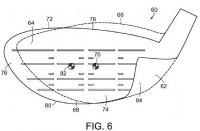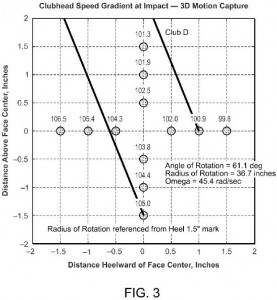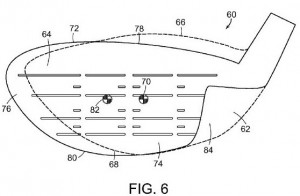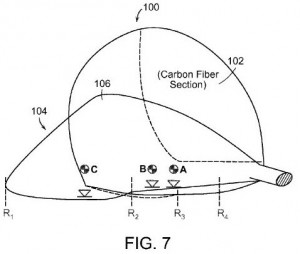How Would You Like an Extra 7 MPH of Ball Speed? This Titleist Invention May Get You There
Want to increase your ball speed by 7 mph? Work on your toe shot!
That’s right, the impact position of the golf ball that is the most common miss by amateur golfers generally produces the highest ball speed. Now that you know this you will always find the center of the face. You’re welcome! Of course there is a little more to hitting the long ball than simply toe’ing it.
An Acushnet patent application that recently published as US Pub. No. 20140171219, titled “Toe-Biased Golf Club,” provides some interesting data and an interesting club head design that just may be the Titleist 917 driver. OK, it is a pretty safe bet that the design will not be the 917 driver, but it would be pretty awesome if it was (ignoring the fact that such a move would probably put them out of business).
Wrap your head around this information and design!
[0029] FIG. 3 is a plot of a matrix of club head speeds (in mph) measured at a variety of points on the club face of a driver by a high-speed 3D motion camera. The x-axis depicts the distance, in inches, horizontally from the center of the club face towards both the heel and toe of the face. The y-axis depicts the distance, in inches, horizontally above the center of the club face towards both the crown and the sole of the face. It can be seen that, for these launch conditions, the clubhead speed gradient horizontally across the club face (from heel to toe) is almost 7 mph (99.8 mph at the location closest to the heel and 106.5 mph at the location closest to the toe), and the clubhead speed gradient vertically up the club face (from crown to sole) is almost 4 mph (101.3 mph at the location closest to the crown and 105.0 mph at the location closest to the sole). As such, the “fastest” location on the club face is not at its geometric center but towards the toe. To take advantage of this high-speed location on the club face, the sweet spot must be moved toe-ward.
[0033] Referring to FIG. 6, in another embodiment of the present invention, the heel portion of the club face and sole is removed, allowing the weight of the club and, therefore, the c.g., to be moved toe-ward. A conventional driver-type club 60 is depicted in cross-hatch and has a heel portion 62, a toe portion 64, a crown 66, a sole 68, and a geometric center 70. An inventive driver 72 of the invention is depicted in solid line and has an abbreviated heel portion 74, an elongated toe portion 76, a crown 78, a sole 80, and a translated center point 82. A large section of the heel of the conventional club face has been replaced, 84, that allows the weight to be moved towards the toe.
[0034] The center of gravity (c.g.) of the club head is preferably translated toe-ward in an equivalent magnitude as the translated center, although in an alternative embodiment, the c.g. of the club head is not congruent with (directly behind) the translated center–it may be either fore (towards the toe) or aft (towards the heel) of said position. The weight from any or all of the crown, sole and skirt/side of the club head can be moved toe-ward to adjust the c.g. of the club head toe-ward. Additionally, a section of the crown closest to the point where the shaft attaches to the club head may be formed from a lightweight material, such as carbon fiber composites, aluminum, magnesium, thermoplastic or thermoset polymers, so that additional weight can be re-deployed towards the toe section.
[0036] An alternative embodiment of the inventive club head, which may or may not fall within the USGA limits for size, is depicted in FIG. 7. A conventional shaped club head 100 is shown in top view with a centrally located c.g. (and sweet spot) referenced as A. As discussed in more detail below, the crown of the club head 100 may have a section removed and replaced (defined by cross-hatch) with a lightweight material 102, allowing weight to be moved toe-ward to adjust the c.g. and sweet spot toe-ward, per the inventive club head. In the conventional club head 100, the bulge of the hitting face has a single radius of curvature centered at A and axis R3. In the conventional club head 100, the bulge of the hitting face has a single radius of curvature centered at A and axis R3. The inventive club head, however, has the c.g. and sweet spot moved toe-ward to B and has a bulge having at least 2 radii of curvature, one centered at axis R2 and the second centered at axis R4. Referring to FIG. 8, the multiple radii of curvature, R1 and R2, of the inventive club head are depicted, with the center of the two radii of curvature being translated a certain distance, DELTAz, towards the toe of the club head.
[0037] In another, potentially non-conforming embodiment, the club head 104 has a longer hitting face with a shallower-depth crown and body portion 106. The c.g. center is translated out towards the toe of the hitting face and is referenced as C. In this embodiment, the bulge of the hitting face has at least two radii of curvature, one centered between axis R.sub.1 and R.sub.2, and the second centered at axis R.sub.4 (between R.sub.2 and the heel).
The only problem with this design (OK, it is not the “only” problem) is that your heel misses become whiffs!
David Dawsey – The Golf Patent Lawyer
PS – follow me on Twitter (@GolfPatents) and sign-up HERE to receive posts via email.
PPS – If you like what we are doing, please considering helping us out and make your online gear purchases through our Amazon affiliate link. Every little purchase helps us keep the site up and running! Thanks.




